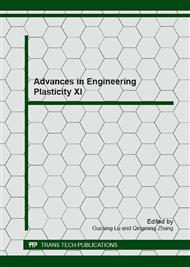p.501
p.505
p.509
p.514
p.518
p.522
p.526
p.530
p.534
Numerical Study of Round-Robin Tests on the Split Hopkinson Pressure Bar Technique
Abstract:
It is known that the split Hopkinson pressure bar (SHPB) technique has not been standardised yet. The standardised SHPB technique is necessary in order to provide guidelines for determining the intrinsic material properties. This paper examines whether consistent results can be achieved from various sets of SHPBs. Finite element analysis has been conducted using ANSYS/LS-DYNA. Numerical simulation of the round-robin tests was conducted to study the consistency of results for OFHC copper, which were obtained from three sets of apparatus, namely: 12.7 mm diameter SHPB made from the AISI 4140 steel, 13 mm diameter SHPB made from the high strength steel (HSS) and 14.5 mm diameter SHPB made from maraging steel 350 (AISI 18Ni). The current study shows that consistent flow stresses (within an acceptable error of 2.5%) were obtained from those three sets of SHPBs, which indicates the possibility of SHPB standardisation in the future.
Info:
Periodical:
Pages:
518-521
Citation:
Online since:
January 2013
Authors:
Price:
Сopyright:
© 2013 Trans Tech Publications Ltd. All Rights Reserved
Share:
Citation:


